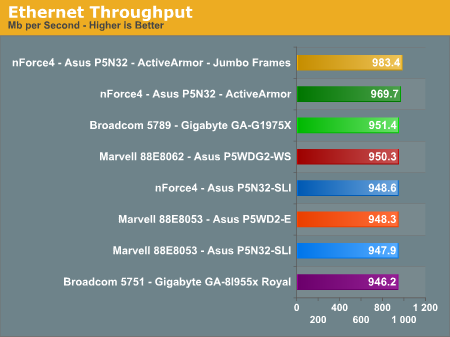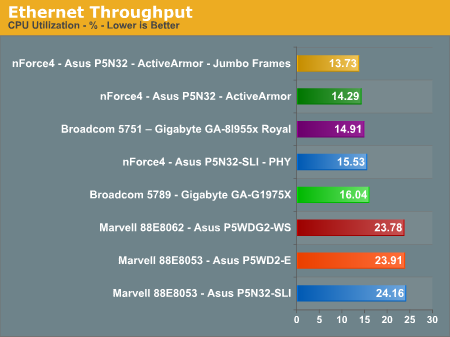Asus P5WD2-E Premium: Intel 975X for the Enthusiast
by Gary Key on January 16, 2006 12:05 AM EST- Posted in
- Motherboards
Ethernet Performance
The current motherboard test suite includes LAN performance measurements. All of these boards utilize PCI Express controllers with the only difference being the supplier of the core logic.
The Windows 2000 Driver Development Kit (DDK) includes a useful LAN testing utility called NTttcp. We used the NTttcp tool to test Ethernet throughput and the CPU utilization of the various Ethernet Controllers used on the Intel 975x motherboards.
We set up one machine as the server; in this test, an Intel system with an Intel CSA Gigabit LAN connection. Intel CSA has a reputation for providing fast throughput and this seemed to be a reasonable choice to serve our Gigabit LAN clients.
At the server side, we used the following Command Line as suggested by the VIA whitepaper on LAN testing:
All standard Ethernet tests were performed with standard frames and the NVIDIA Active Armor suite was disabled unless otherwise noted. Gigabit Ethernet supports Jumbo frames as well and provides a further reduction in CPU overhead. We added another test scenario in which ActiveArmor and Jumbo frames were enabled on the Asus P5N32-SLI Deluxe board via the 6.82 WHQL platform driver set. This is shown for illustrative purposes and shows the favorable impact of this technology.
The Windows 2000 Driver Development Kit (DDK) includes a useful LAN testing utility called NTttcp. We used the NTttcp tool to test Ethernet throughput and the CPU utilization of the various Ethernet Controllers used on the Intel 975x motherboards.
We set up one machine as the server; in this test, an Intel system with an Intel CSA Gigabit LAN connection. Intel CSA has a reputation for providing fast throughput and this seemed to be a reasonable choice to serve our Gigabit LAN clients.
At the server side, we used the following Command Line as suggested by the VIA whitepaper on LAN testing:
Ntttcpr -m 4 ,0,‹server IP› -a 4 -l 256000 -n 30000On the client side (the motherboard under test), we used the following Command Line:
Ntttcps -m 4 ,0,‹client IP› -a 4 -l 256000 -n 30000At the conclusion of the test, we captured the throughput and CPU utilization figures from the client screen.


All standard Ethernet tests were performed with standard frames and the NVIDIA Active Armor suite was disabled unless otherwise noted. Gigabit Ethernet supports Jumbo frames as well and provides a further reduction in CPU overhead. We added another test scenario in which ActiveArmor and Jumbo frames were enabled on the Asus P5N32-SLI Deluxe board via the 6.82 WHQL platform driver set. This is shown for illustrative purposes and shows the favorable impact of this technology.










20 Comments
View All Comments
kilkennycat - Monday, January 16, 2006 - link
If the board is not 100% compatible, both physically and electrically with the upcoming Conroe family of processors, I suggest that everybody take a pass. It would be just another case of Intel screwing us again with fast-track (deliberately-?)planned obsolescence ---- just as they did on the LGA775 family when the earlier boards and chipsets were (er...) "found" not to be compatible with their dual-core offerings ---which of course nicely inflates demand for Intel chipsets. And again where Yonah has exactly the same pin-count as the Pentium-M, but deliberately physically incompatible such that even the latest Pentium-M motherboards will not work with Yonah. After all, Intel needs to recoup its recent $350million investment in expanding its chip-set fabrication capability and as fast as possible. Would not like to disappoint the stockholders.Also a corollary question --- is the 975X chip-set itself fully compatible with Conroe, or is it going to have a short and unhappy life like the 915/925 chipset ??
Gotta really admire Intel in the past couple of years. While their processor engineering lost its way, their marketing gurus have become geniuses at finding all sorts of neat ways of lubricating the screw and keeping the cash rolling in.
danidentity - Monday, January 16, 2006 - link
Besides price, what is the advantage of this board over the P5WDG2-WS? Is the P5WD2-E a better overclocker than the P5WDG2-WS? Would you recommend the P5WD2-E over the P5WDG2-WS, price aside?Gary Key - Monday, January 16, 2006 - link
The P5WD2-E is targeted towards the overclocking market and for mainstream use as it should come to market about $35~$50 less than the P5WDG2-WS. The other advantage it holds is the additional PCI-E slots and one additional PCI slot if you need them, otherwise the PCI-X slots on the G2-WS will certainly hold an advantage for the workstation crowd.
I personally think the G2-WS is a better board at this point in the release cycle mainly due to a more mature bios and the 8-phase power solution. However, we have several more 975X boards to review and will hold final judgement until that testing is completed.
mostlyprudent - Monday, January 16, 2006 - link
In the initial 955EE review, there was a claim that the high heat levels might be related to the Intel supplied motherboard. Was there any difference with this ASUS board?Gary Key - Monday, January 16, 2006 - link
We did not notice the same thermal issues the first set of the Intel D975XBX boards had with the 955EE. In fact, our replacement D975XBX solved the initial thermal issues we noticed. However, the 955EE still runs very warm, we noticed 49c at idle and up to 68c under load on the Asus board with either the Gigabyte G-Power or Thermaltake Big Typhoon coolers. The provided Intel heatsink (840EE) ran at 55c idle and up to 73c under load but we understand this might not be the heatsink shipped in the retail kit. We are trying to procure one at this time to test it.
Marlin1975 - Monday, January 16, 2006 - link
You say there is a problem with the 882 chips? Can you run the same test on boards that used the same south bridge with a Cmedia sound chip. I know a lot of boards used the c-media at first and am whondering if this is maybe a south bridge problem or just another sign of the low quality items/drivers that realtek seems to make.Never been a realtek fan. Weather it be their low quality sound chips or their drivers.
Gary Key - Monday, January 16, 2006 - link
The 882 family of codecs is very good for an on-board solution. I believe there is still a lot of work to be done in the drivers. However, the improvements made between the R1.20 release up to the R1.29 release have been significant. We actually could watch our BF2 benchmark come to a stop during the aircraft flyovers up until the R1.27 release. There is still some stuttering and frame rates drop into the teens but overall the CPU hit rate is around 9% compared to a 67% CPU hit in drivers up to R1.26. The overall sound quality has improved in games like Serious Sam II and F.E.A.R. also. We have not tested a 975X board with the CMedia solution but have just finished testing one with the Sigmatel solution (next article).ProviaFan - Monday, January 16, 2006 - link
The review states that with two ATI cards inserted, the other PCI-E slots are not usable. Is this due to a real hardware limitation, or is it only because the ATI cards' coolers are too big? An example of a usage scenario that prompted this question: could I put a graphics card in one 16x slot running at 8x, an 8x PCI-E SCSI adapter in the other physical 16x slot, and then perhaps a 1x card in one of the remaining slots?Gary Key - Monday, January 16, 2006 - link
The slots are physically not available due to the two slot cooling solutions used on the cards. This would hold true for the 6800 Ultra or 7800GTX 512mb edition cards.
Your scenario about the slot assignments would work.
coldpower27 - Monday, January 16, 2006 - link
Interesting on the voltage for the CPU though having only 1.200V as the bottom limit seems a little bit limiting from my persepctive, good gaming performance though as it typically runs only 2nd to the Intel Nforce 4 SLI.I also agree that 8 Phase Power would be nice, maybe in a future revision that is made to support Intel's NGMA processors.